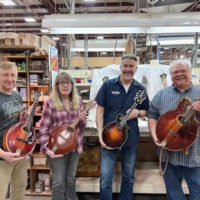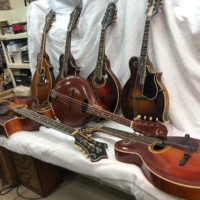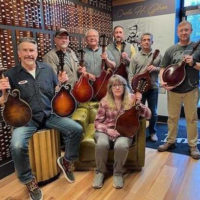David Harvey to present The Early History of Gibson in Missouri/Ohio
![]()
David Harvey, who oversees production of mandolins and acoustic instruments at Gibson in Nashville, will be offering a couple of presentations this spring on the history of the company which employs him. Though Gibson has seen several owners since it passed from the Gibson family, there are few who understand its early days as well as Harvey, or the instruments that defined its beginnings.
Gibson goes back to the late 19th century, when founder Orville Gibson began to build mandolin family instruments. The actual legal entity was launched in 1904 as the Gibson Mandolin-Guitar Mfg. Co. Ltd, based in Kalamazoo, MI, where they remained until 1984 when all manufacturing was moved to new facilities in Nashville, a process that had begun several years earlier. Following multiple acquisitions and changes in the musical instrument market, the company is now officially known as Gibson Brands, Inc.
Those of us in the bluegrass world are largely focused on the company’s glory days, when they were the premier builders of the mandolins and banjos that defined the sound of bluegrass. While banjos are no longer built by Gibson, and the company’s focus is directed towards electric guitars, the mandolin still has its place in the Gibson hierarchy, and they still build among the finest of them there in Tennessee.
Harvey is venturing to Springfield, MO this weekend for an April 9 presentation entitled From Orville to Loar at The Acoustic Shoppe, operated by the Chapman family, long time purveyors and producers of quality bluegrass music. Starting at 6:30 p.m., he will detail the story of Gibson from Orville’s first shop right up to the time when Lloyd Loar, the legendary luthier who designed the F-style mandolins and the Mastertone banjos, held David’s position with the company in the ’20s.
He will be bringing nearly two dozen examples of these early model Gibson guitars and mandolins, provided to him by a number of collectors, including a few plainly historic examples. He will have several F-4 mandolins, a 1929 Loar F-5, plus the legendary “Drunk Loar,” so named for the story that a previous owner once threw it across a room in a drunken rage. Also on hand will be some early guitars, including a jumbo model that was the first Gibson guitar ever shown on television.
The presentation will be watchable by video stream on The Acoustic Shoppe Facebook page, but anyone with an interest in these classic instruments and their story is encouraged to come to the shop in person to take it in. Video can’t possibly convey the look, sound, and smell of these historic mandolins and guitars, nor the opportunity to hold one in your hands.
On May 28, Harvey will give a similar, but more expansive talk at Mitch and Cindy’s Bluegrass Jamboree in Cortland, OH. For this one, David will be able to bring even more instruments, and cover the early days of Gibson in greater detail. He promises to share further information about that in the near future.
When we asked about production of Gibson mandolins these days, he said that they were so back ordered at this point that it didn’t even merit discussion. If you have had your heart set on one of the models still available from Gibson, you might want to get in line before the back orders get even further behind.
When stock is available, David says it is delivered to The Gibson Garage in Nashville, the company’s new retail facility on 10th Street downtown in Nashville.
Here are a few photos of the instruments that will be at The Acoustic Shoppe with Harvey on Saturday.
The post David Harvey to present The Early History of Gibson in Missouri/Ohio appeared first on Bluegrass Today.



